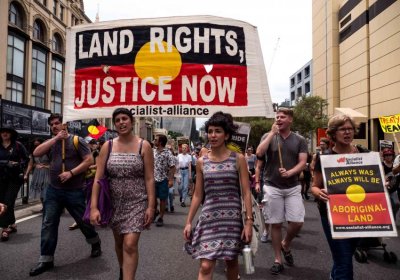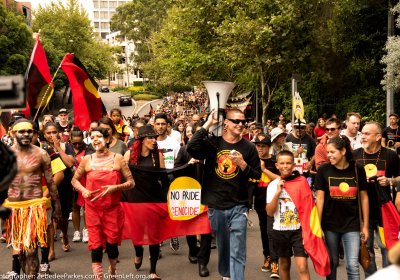If national unity and harmony are the goals for Australia’s national day, then January 26 is no longer, if it ever was, fit for purpose. It does not meet its objective and, no matter how much it “disappoints” Prime Minister Malcolm Turnbull, we need to re-think Australia Day.
Invasion Day
In an event organised by Fighting In Resistance Equally (FIRE) on January 26, more than 10,000 people gathered at The Block in Redfern to pay their respects to Australia’s first nations and show support for Indigenous rights.
Ken Canning, chairman of the Indigenous Social Justice Association, kicked off the event by saying: “It’s really great to see all of these faces here. We want this to be a healing day and we need this to be a peaceful event.” He added: “We are peaceful people despite what the media says.”
This year marks 230 years since British military forces invaded Gadigal land and declared British rule over this continent. One hundred and fifty years later a group of Aboriginal men and women met in the Australia Hall in Sydney to declare January 26 a Day of Mourning.
Every year the Invasion Day protests grow as more and more people realise it is not a day to celebrate but a day to say "enough is enough" and stand with first nations’ people of this country.
Representatives at the annual meeting of the Australian Local Government Association voted on June 20 to back a motion by Hobart city council to push for the federal government to change the date of Australia Day.
Hobart city council voted in April to sponsor changing Australia Day from January 26, a date many Indigenous people regard as Invasion Day.
This year, the City of Fremantle moved some Australia Day events to January 28, after local Aboriginal elders said January 26 was not a day to celebrate.
“This brings pride to our people. This is a turning of the tide!”, First Nation’s activist Ken Canning told the thousands on the streets for the Invasion Day march from Redfern to Chippendale on January 26.
Indeed, it was.
The Council of Australian Postgraduate Associations (CAPA) and The National Aboriginal and Torres Strait Islander Postgraduate Association (NATSIPA) support renaming January 26 as “Invasion Day”. The two organisations decided this on January 15.
They are encouraging a rethink of the meaning of "Australia day" on January 26 to support justice for Aboriginal and Torres Strait Islanders. They are also urging people to attend one of the many nationwide protests on January 26 (see below).
When Fremantle councillors voted in August last year to end the Australia Day fireworks display that it had been running for the past eight years, I fully expected a conservative backlash. But even I was surprised to see the decision featured in news bulletins for months on end.
On one level the whole thing is bizarre. Local governments are not obliged to do anything special on January 26 and most of them don't.
What drove the conservative media and Coalition politicians into a frenzy was the council's reason for doing dropping the fireworks display.
As Invasion Day approaches, Murri leader Sam Watson told Green Left Weekly that January 26 was “only a date when a motley collection of boats made landfall on Gadigal country to establish the colony of NSW”.
“It is important to mobilise and march [on Invasion Day] to remind everyone that an illegal invasion took place on this soil," he said..
“They came here to launch a war of genocide against the 500 sovereign nations of this land.
“They came to invade as a fully-armed military force. They massacred and slaughtered tens of thousands of innocent people.
Early last year, an academic debate over Invasion Day erupted at the University of NSW. Apparently, some well credentialed people are offended that the term “invasion” is used to describe January 26.
I would be quite happy not to have to use that term. Stop and think for a few minutes: that would mean altering history or going back in time and ensuring the invasion of this country, now called Australia, never happened.



- Previous page
- Page 4
- Next page










